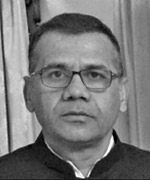Small But Significant
 R.C. Sharma
R.C. Sharma
The BSF’s role during the 1971 war is well documented. BSF battalions were an active part of combat in both eastern and western theatre along with the army. The nation recognised the gallantry and bravery of the BSF officers and men during the 1971 war. Many were bestowed with gallantry awards, prominent among them, R.K. Wadhwa, Assistant Commandant who was awarded Mahavir Chakra (posthumously).
The only conflict after 1971 that India saw with Pakistan was the Kargil conflict wherein the army fought valiantly in high altitude terrain and evicted Pakistan regulars who intruded in the garb of mujahideens. After suffering humiliation and defeat, Pakistan was forced to vacate the area occupied through clandestine intrusions. The Pakistan Army withdrew by 17 July 1999 barring some areas, which were cleared by 25 July 1999. The Indian Army declared the successful conclusion of Kargil operations on 26 July 1999. The day every year is celebrated as ‘Kargil Vijay Diwas’. The moot question is how such a largescale intrusion took place without being detected by intelligence agencies and troops on the ground. Why these intrusions went undetected remains a mystery.
Border Security Force is deployed on the LC under operational control of the army. This BSF deployment is widespread, scattered over the whole brigade defended sector. Like normal border guarding, there are two stakeholders of the BSF on the LC, which act as the eyes and ears of command. These two stakeholders are BSF troops on ground and BSF intelligence set up. There is a need that the inputs from these stakeholders are given due weightage, and acted upon to avert a crisis which in the long run could threaten national security.
An important caveat while penning this piece on the role of BSF in the Kargil conflict is that the material gathered is from open sources. As per this information, it was the shepherds who first sighted some men digging and informed local elements of the army. This information initially was not given due weightage; however, later patrols sent authenticated the authenticity and seriousness of the information.
BSF played a small and significant role in the Kargil conflict, which has remained anonymous to people at large. In his book Kargil: From Surprise to Victory, General V.P. notes says that 121(I) infantry brigade with one BSF and three in
Subscribe To Force
Fuel Fearless Journalism with Your Yearly Subscription
SUBSCRIBE NOW
We don’t tell you how to do your job…
But we put the environment in which you do your job in perspective, so that when you step out you do so with the complete picture.







